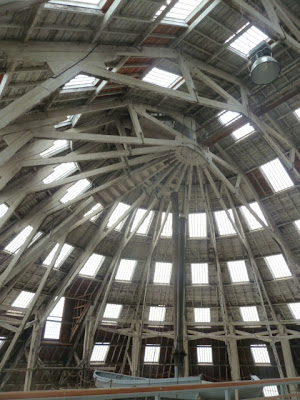I spent the whole day at Chatham Docks. It was that good and there is so much to see.
It costs about £15 to get into the historic dockyard, but the ticket lasts for a year and you can go back as often as you want.The docks have been where major shipbuilding of British warships have taken place for over 600 years. The last one, a submarine, was built in the 60s. The Medway has also been a place where major parts of the fleet have been kept over the centuries.Whilst much of the area has been cleared as part of redevelopments, an area has been retained and reused as an historic maritime centre, together with some businesses.
My first stop was the " Big Space". This is a massive timber framed building, which at one stage had tar covered paper on its roof,before this was replaced by zinc. It houses all the big stuff, plus the RNLI exhibition.When I first saw it, I thought it was a contemporery addition to the other historic big sheds.
When I said that I was going to try and raise money for the RNLI and RSPB on this trip, one or two people commented on the wealth of the RNLI and that they have the very best, and the most expensive of equipment. Furthermore it is housed in some very impressive buildings.The implication was that the charity was doing alright and didn't need any more money. Frankly, I wondered if I'd chosen the wrong charities.Today changed all that for me and removed any doubts I may have had.


When you read about the sacrifices the lifeboatmen have made, and hear of the loss of their boats and their lives and you combine this with the testimonies of swimmers, fishermen, dog walkers, windsurfers and yachtsmen, then you realise what a fabulous and typically British institution this is. If they have the best of equipment, it is only so that it can be put to saving ordinary people. Furthermore, the lifeboatmen are putting their own lives on the line and they deserve to have the odds stacked on their side by having the best equipment at their disposal.
The last loss of a lifeboat seems to have been as recently as 1962, but I'm sure there will have been the loss of lifeboat men's lives since then. So it is not just in the early days when there was true heroism and sacrifice.
I was incredibly moved by the exhibition, and I was touched by Winston Churchill's comments about the character that persists in people who risk everything to save others. This is in peacetime and where there is no financial reward. I will be campaigning ever harder for this organisation.
The next stop was much lighter emotionaly.It was the rope making exhibition. Rope making is an activity that has been going on for centuries. It still takes place in the longest brick built building in Europe. It is a quarter of a mile long with no intervening walls. It's an amazing space to look down.
The guy (Mr. Steve- to you folks please) who led the talk was a right character. He took on the no-nonsense persona of a 1850s shop foreman. He explained that there were 31 miles of rope used in the construction of HMS Victory when it was built at Chatham.He explained the origins of such phrases as "to swing a cat",and "to let the cat out of the bag", It reminds us of the maritime origins of so many of the things we say without realising it.
The next guided tour was of the cold war submarine, which was the last vessel to be built at Chatham. It had an electric motor and the batteries were recharged by a diesel engine when it could be near the surface to have access to a source of air. It was therefore silent in operation.It was in service until the late 90s
I reckon I've got more space inside Hylje than the captain had in his deluxe cabin.
The Gannet is one of those part steam, part sail,part iron, part wood boats that emerged at the time Brunel was designing the SS Britain. it saw a bit of active service but was used mostly to impress the natives and exercise a bit of diplomatic muscle.
It had been decommissioned and used as a static training ship before it was restored.This sort of ignoble alteration seems to have been the destiny of so many fine ships, many of which were used as floating prisons. At least this one has survived and had her dignity restored.
Under the floor of one of the buildings on the site they unearthed the timbers of what seems to have been a single ship. Archaeologically it is as significant as finding the Mary Rose.
In the big shed there was an interesting variant on the rudder.It was on a launch and it's moved by a small wheel. It is supposed to make steering when going backwards so much better.
There is so much more I could report, but there is just too much.Back on Hylje and in my strange post mooring it is good to feel connected through this trip to this heritage of sea faring.
However, I feel that I am spoilt by the luxury of being able to chose where I sail and when I go. So many who have defended our shores or, and here is another plug, have sought to save the lives of those who had no such choice, deserve our total respect and support.In the last 5 years the RNLI has saved 38,000 people. It is perhaps not so well known that they continued to operate in the 2 world wars. In the first one they saved 5,332 lives, and in the second one 6,376 lives. Also 19 lifeboats were involved in evacuating troops from Dunkirk.If this stirs you, then you know what to do.
www.justgiving.com/stephen-munday/














































































